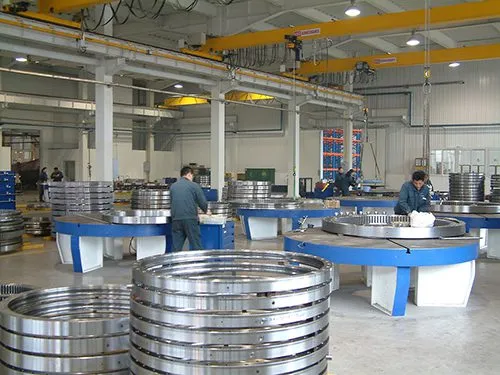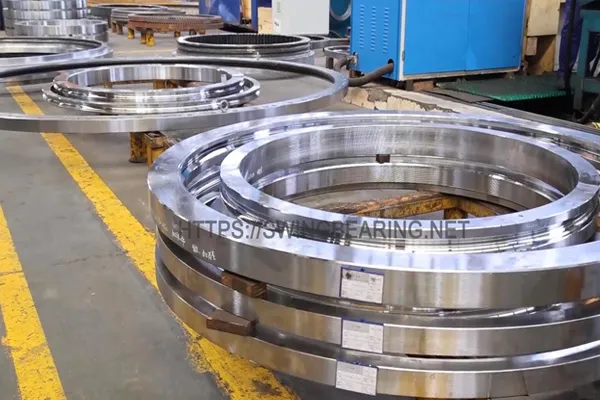
The excavator swing bearing is a force transmission component that rotates relative to the upper and lower body of the excavator, used to support the mass of the upper body and withstand working loads. The inner race is connected to the lower body, the outer race is connected to the upper body, and the inner gear ring on the inner race is engaged with the small gear of the rotary motor. When the rotary motor rotates, the upper body is driven to rotate by a small gear. The structure of the swing bearing is shown in Figure 1:

The swing bearing of the lubricating excavator is lubricated with lubricating grease, which is divided into two parts: the lubrication part of the inner cavity of the slewing bearing (rolling body and raceway), and the lubrication part of the inner gear ring and the small gear of the slewing motor. The inner cavity of the slewing bearing is lubricated by adding lubricating grease through a lubricating nozzle located on its outer race. The inner gear ring of the swing bearing and the small gear of the slewing motor are lubricated with pre added lubricating grease, as shown in Figure 2:

The sealed swing bearing has two oil seals, inner and outer. The outer oil seal is fixed to the lower part of the outer circular surface of the inner race, and its main function is to prevent dust and prevent external debris from entering the inner cavity of the slewing bearing. The inner oil seal is located at the upper part of the inner circle of the outer race of the swing bearing, and its main function is to prevent the lubricating grease from overflowing from the inner cavity of the swing bearing. The lubrication cycle for the inner cavity of the slewing bearing should be between 250 and 300 hours. The filling of lubricating grease can be completed in four steps, that is, once every 90 ° rotation of the excavator, until the lubricating grease overflows from the outer oil seal.
There are two types of faults that are prone to occur in the swing bearing of excavators:
One reason is that the excavator swing bearing often operates under heavy load and impact conditions, and the working environment is harsh, resulting in rapid wear of the inner and outer oil seals of the slewing bearing, leading to grease leakage.
The second is that the bottom plate connecting the upper turntable and the swing bearing deforms severely under eccentric load conditions, causing concentrated load on a small portion of the rolling element, resulting in damage to the rolling element, inner race, outer race, and slewing motor.
Oil seal wear When the excavator rotates, the outer race and oil seal rotate relative to the inner race, which can cause the inner oil seal to wear and gradually become thinner. When the inner oil seal becomes thinner, its sealing effect decreases. At this time, if too much lubricating grease is added to the inner cavity of the slewing bearing or the working temperature increases, it will cause the pressure in the inner cavity of the slewing bearing to increase, and the lubricating grease will leak out from the inner oil seal.
If the lubricating grease is not evenly applied to the same part of the inner cavity of the slewing bearing, it will cause uneven application of lubricating grease, resulting in the outer oil seal being squeezed out and falling off, or a large amount of lubricating grease overflowing.
If the quality of the lubricating grease is poor, the lubricating grease will become thinner when the temperature of the friction part of the slewing bearing increases. The diluted lubricating grease will leak out from the outer oil seal.
If there is abnormal noise or unstable rotation during the rotation process of the swing bearing excavator, it may be caused by severe wear of the rotary bearing raceway and rolling body, and excessive clearance between the inner and outer races. During the rotation process of the swing bearing, lubricating grease is squeezed out from the inner and outer oil seals, which can cause damage to the inner and outer oil seals.
Oil seal fault diagnosis method
Open the lubricating grease inspection cover of the inner gear ring of the slewing bearing to check if there are any broken fragments of the inner oil seal in the oil chamber of the inner gear ring. If there are broken fragments of the inner oil seal in the oil chamber of the inner gear ring, it indicates that the inner oil seal has been damaged.
Carefully inspect the outer oil seal along the outer oil seal of the swing bearing to see if there is local, sectional, or even peripheral leakage. At the same time, check whether the installation groove on the outer oil seal and the inner race of the slewing bearing are fixed, in order to determine whether the outer oil seal is damaged. When checking the outer oil seal, it must be done while the excavator is rotating. If the outer oil seal rotates simultaneously while the excavator is rotating, it indicates that the outer oil seal has become loose and needs to be replaced with a new one.
Reasonable clearance of the swing bearing is a prerequisite for ensuring the normal operation of the inner and outer oil seals. If the clearance exceeds the specified value due to the wear of the raceway and rolling element, it will inevitably damage the inner and outer oil seals, thereby affecting the normal use of the excavator. At this point, the following methods can be used to detect the clearance of the slewing bearing:
First, park the excavator on a flat and solid ground, fully extend the jib, fully retract the bucket, and then adjust the boom height so that the bucket pivot is consistent with the boom root pivot height h, as shown in Figure 3:

Secondly, place the magnetic gauge holder at the rear of the lower frame, install the dial gauge on the magnetic gauge holder, so that the measuring rod end of the dial gauge contacts the bottom surface of the outer race of the swing bearing, and adjust the dial gauge pointer to a position of 3-4 mm as the measurement reference point, as shown in Figure 4:

Once again, operate the boom and lower the bucket to the ground. Use the bucket to lift the idler end of the excavator track, so that the front end of the track is 15-20mm above the ground, as shown in Figure 5:

Finally, observe and record the dial indicator reading while the excavator is in the state shown in Figure 5. If the dial indicator value is within the range of 0.5~3m, it indicates that the clearance of the swing bearing is normal; If it exceeds 3mm, the slewing bearing should be repaired or replaced.
(1) Replace the outer oil seal
If it is determined that the outer oil seal of the swing bearing has been damaged, it must be replaced with a new one. Both the inner and outer oil seals of the slewing bearing are in the form of sealing strips. After installation, it is necessary to use universal adhesive (such as acrylic adhesive) to align and bond the two ends of the sealing strip together. The steps for replacing the outer oil seal are as follows:
Firstly, remove the old oil seal;
Secondly, clean the sealing groove with diesel or gasoline;
Once again, use a screwdriver and a hammer to install the new sealing strip into the sealing groove; Then use universal adhesive to bond the joints at both ends of the new sealing strip together;
Finally, add lubricating grease to the sealing chamber of the slewing bearing.
(2) Replace the lubricating grease
If the oil seal leaks due to improper selection of lubricating grease, the original lubricating grease in the slewing bearing should be cleaned out first, and then lithium molybdenum based lubricating grease should be added.
There are two methods to clean the original lubricating grease inside the slewing bearing:
Firstly, while the slewing bearing is slowly rotating, add new lubricating grease to several lubrication nozzles to fully and evenly fill them until the original grease is squeezed out from the inner and outer sealing strips;
The second is to remove the screw plug for installing the rolling element of the slewing bearing, and add new lubricating grease at several lubrication nozzles to allow the original lubricating grease to overflow from the screw plug hole.
(3) Repair the slewing bearing
The raceway and rolling element of the slewing bearing are severely worn and need to be repaired. The inner oil seal of the slewing bearing is worn and needs to be replaced. When replacing the rotary bearing oil seal, the upper and lower bodies must be separated. When disassembling the upper body, it is necessary to first loosen and remove the surrounding bolts of the rotating part, then remove the rotating motor and some hydraulic oil pipes, and finally use a crane to lift the upper body down. Rotary bearing raceways and rolling bodies can be repaired using machining methods. The method of replacing the inner oil seal is basically the same as replacing the outer oil seal.
The method of installing the slewing bearing is the reverse of the disassembly sequence. When installing the swing motor, the small gear of the swing motor should be meshed with the inner gear ring of the swing support first, and then the angle of the upper turntable should be adjusted to align the bolt installation hole of the swing motor with the installation hole of the upper turntable.
